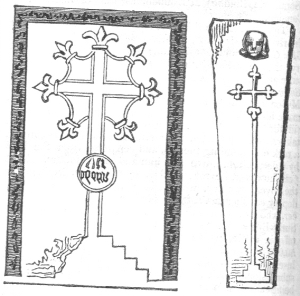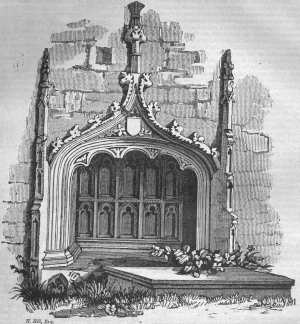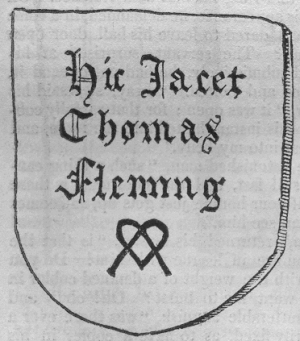Ancient Tombs in the Collegiate Church of Youghal, County Cork
From The Dublin Penny Journal, Volume 1, Number 46, May 11, 1833
We return to the Collegiate Church of Youghal, of which we recently gave an account in our 44th number, for the purpose of noticing some of the most remarkable of the ancient tombs contained within its walls. Of these, many of the most ancient are, oblong flag stones, ornamented with crosses, of which an infinite variety of forms are to be found in our ancient abbeys. The annexed wood cut represents one of those monumental stones, bearing the date of 1517, inscribed within a circle on the shaft of the cross, and traditionally said to be the tomb of a mayor of Youghal. This monumental stone is in the north transept.

Another slab of this description, but apparently of greater antiquity, which is within the nave, is remarkable in having a head sculptured in bold relief above the cross--a circumstance not usual in such monuments. This monumental stone, is also attributed to a mayor of Youghal, whose name was Ronayne, and supposed to have lived in the reign of Elizabeth.
But the most interesting of the Youghal monuments, for its architectural beauty and antiquity, is the altar tomb on the north side of the choir, which is simply noticed by Smith, as a very old tomb without date, and of which no representation has been hitherto published. This beautiful monument exhibits a good specimen of the style of old English architecture prevailing in the fifteenth and sixteenth centuries, and is probably nearly coeval with the erection of the church. It is richly adorned with trefoil compartments, and its style of execution is admirable.

The name of the person for whom this tomb was erected, is simply inscribed on the shield within the canopy--" Hic jacet Thomas Fleming" -- but without date, and nothing is preserved bytradition respecting him. He was, doubtless of the noble and ancient family of Slane, in which the name of Thomas was usual.

The reader will find an ample account in Smith's History, of the more recent tombs contained with in the south transept, which was formerly a chantry dedicated to the blessed Saviour, but purchased, as we have stated in our 44th number, from the Mayor and Corporation, in 1606, by the earl of Cork, and converted into a mortuary chapel or tomb house for himself and family. The principal monument is that of the Boyle family, which was erected by the first earl of Cork, and which, as Mr. Brewer observes, is "so loaded with effigies and escutcheons, and illustrated by inscriptions so very copious and explicit, that the monument may be truly said to present heraldic and genealogical memoirs of the founder and his family." In its general character, this monument is very similar to that of the same family in St. Patrick's Cathedral, Dublin, and is chiefly constructed of marble, and the figures of alabaster. The principal figure is that of the earl of Cork himself, represented in armour, in a recumbent position; and below are nine of his children. Another monument worthy of note is that of Richard Bennet and Ellis Barry his wife, who, as appears from the inscription, was "the first foundress of this chapel; which being demolished in the time of the rebellion, and their tomb defaced, was re-edified by Richard, Lord Boyle, Baron of Youghal, who, for reviving the memory of them, repaired this tomb, and had their effigies, cut in stone, placed thereon, Anno Domini. 1619." In this chapel there is an epitaph on Sir Richard Villers, Lord President of Munster, who died in 1626, which, as our friend Mr. Crofton Croker observes, bears a strong resemblance in style to those written by Ben Johnson:--
"Munster may curse the time that Villers came
To make us worse, by leaving such a name
Of noble parts, as none can imitate,
But those whose hearts are married to the state;
But, if they press to rival him in fame,
Munster may bless the time that Villers came!"
P.
